ELEPHANTS & IVORY
ELEPHANTS & IVORY
ELEPHANTS & IVORY
You also want an ePaper? Increase the reach of your titles
YUMPU automatically turns print PDFs into web optimized ePapers that Google loves.
© IFAW/Amboseli National Park, Kenya<br />
Any proposal to reinvent our approach to<br />
conservation and, in the present context, our<br />
approach to the conservation of a single group of<br />
animals such as elephants, requires leadership. 190<br />
Individual people and non-governmental<br />
organizations can only do so much. If the<br />
traditional conservation community chooses to<br />
reinvent itself, then members of IUCN – the World<br />
Conservation Union, both its NGO and government<br />
members, as well as its Specialist Groups; CITES<br />
and the individual Parties to CITES; and the United<br />
Nations Environment Programme (UNEP), among<br />
others, all have opportunities to play an important<br />
role in shaping a new, truly knowledge-based<br />
approach to conservation – including elephant<br />
conservation – for the 21 st Century.<br />
IUCN, backed by its Asian Elephant Specialist<br />
Group and its African Elephant Specialist<br />
Group could begin – following the lead already<br />
established by the Convention on Migratory<br />
Species (CMS) – by recognizing that there are at<br />
least two distinct species of elephant in Africa.<br />
Once that step has been taken, they could<br />
then take the lead in developing appropriate<br />
conservation action plans to increase protection<br />
for these species, individually and collectively.<br />
CITES could return to its original mandate of<br />
protecting vulnerable species from the threats<br />
posed by international trade, rather than working<br />
to facilitate legal international trade in elephant<br />
ivory. 191 Any discussions and decisions about<br />
the ivory trade must properly consider the links<br />
between legal and illegal trade and assess the<br />
feasibility of a new approach that treats elephants<br />
as biological entities rather than political entities<br />
defined by artificial national boundaries. 192 It<br />
would stop any further discussions of downlisting<br />
proposals for elephants, and any additional<br />
“one-off” sales of elephant ivory, and ban the<br />
international ivory trade immediately. Asian<br />
elephants and those African elephant populations<br />
currently on Appendix I have such protection,<br />
at least on paper. International trade in ivory<br />
from elephant populations listed on Appendix II<br />
must also be banned because of the “look-alike”<br />
problem, and because any legal trade provides<br />
cover for poaching and illegal trade in ivory from<br />
Appendix I populations. There is simply no way for<br />
customs officials and merchants to identify ivory<br />
in trade as coming from any particular population<br />
or species, or to separate, unequivocally, legally<br />
traded ivory from illegal ivory.<br />
In their individual capacities, the Parties to<br />
CITES – especially jurisdictions such as China, the<br />
European Union, Japan, and the United States,<br />
could take the lead and set the example by closing<br />
down national markets in elephant ivory, and<br />
tightening up national laws and enforcement to<br />
cut down on illegal trade.<br />
Given the rise in the illegal killing of elephants<br />
and illicit trade in elephant ivory, governments<br />
could use their influence to provide the necessary<br />
support and technical capacity to work with<br />
source, transit and end-user countries to combat<br />
elephant poaching and illegal trade. 193 Unregulated<br />
and uncontrolled domestic ivory markets should<br />
be dismantled wherever they exist.<br />
Governments must commit to and enact<br />
legislative and enforcement reforms to curtail<br />
internal ivory markets. Wildlife crime needs to<br />
be treated with the same seriousness and level<br />
of attention that we give to other transnational<br />
organized crime, such as the drug and weapons<br />
trade, and human trafficking, given the critical<br />
links to national security and governance issues in<br />
many countries. 194<br />
UNEP, for its part, could play a leadership<br />
role in putting knowledge-based conservation<br />
of the environment and all its constituent parts,<br />
including elephants, first and foremost on its<br />
agenda. It could also stop promoting the false<br />
promises of sustainable development, and the<br />
“sustainable use” of wildlife, which these days<br />
has become a euphemism for the commercial use<br />
of wildlife. 195<br />
One can see similar and complementary<br />
opportunities for other intergovernmental<br />
organizations and international conventions<br />
including, especially, the Convention on<br />
Biodiversity. 196<br />
Of course, many in the mainstream<br />
conservation community, especially those who<br />
put economics first, and skeptics masquerading<br />
as “realists” or “pragmatists”, will reject<br />
such suggestions as unrealistic, idealistic and<br />
naïve. Nonetheless, the problem remains that<br />
conservation today is not achieving its objectives<br />
and hasn’t for a very long time. 197<br />
If we really want to conserve elephants and<br />
offer them the protection they so clearly need<br />
and deserve, we have to try new approaches. The<br />
alternative, doing the same things over and over<br />
again and expecting different results, is – to put it<br />
bluntly – the very definition of insanity. 198<br />
83<br />
© IFAW/S. Barbaruah/Kaziranga National Park, Assam, India


